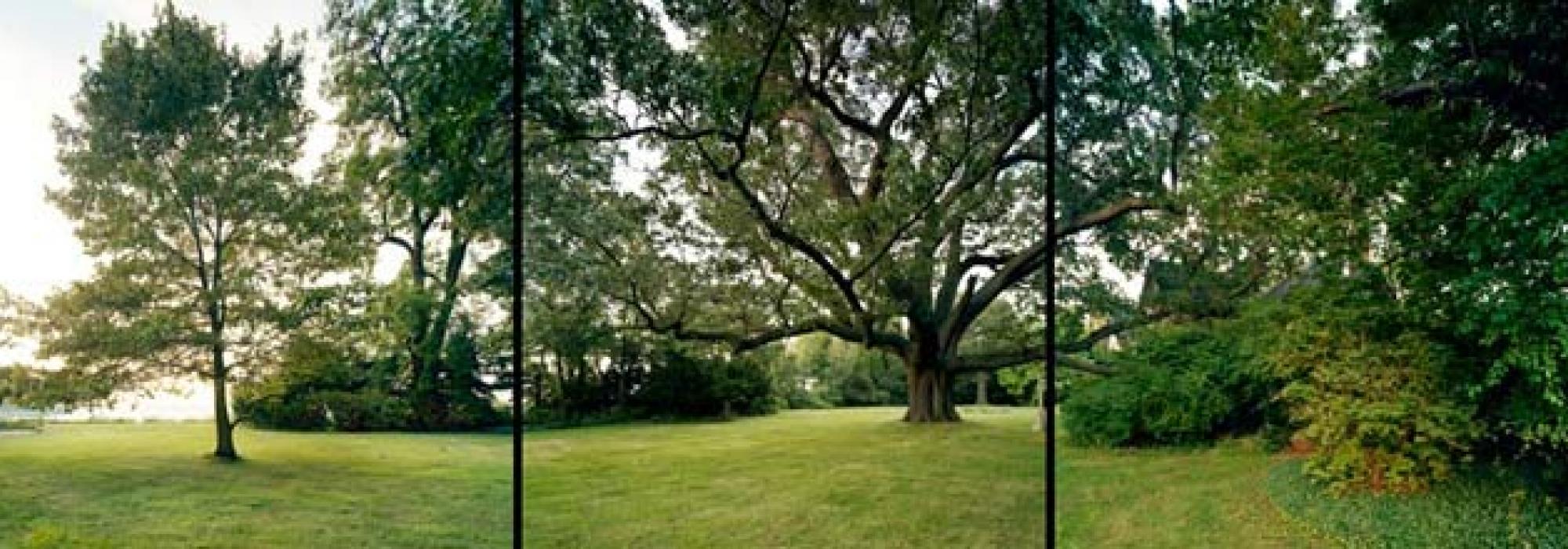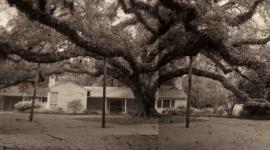Heroes of Horticulture Photography Exhibition Opens at Fellows Riverside Gardens
Media Contact: Nord Wennerstrom, Wennerstrom Communications | T: 202.255.7076 | E: nord@wennerco.com
Features Witnesses to Great Moments in U.S. History
Washington, DC (May 7, 2010) – The photographic exhibition Heroes of Horticulture opens at Fellows Riverside Gardens in Youngstown, Ohio, on Friday May 7, 2010. The exhibition organized by The Cultural Landscape Foundation (TCLF) and the George Eastman House International Museum of Photography and Film, and sponsored by Garden Design magazine, features twenty-four photographs by twelve photographers.
The Heroes are horticultural witnesses to some of the nation’s greatest people and most significant moments, some are hundreds of years old — the Horse Chestnut Tree that shaded suffragette Susan B. Anthony in the late 19th century; Charleston’s Angel Southern Live Oak, a majestic living legacy from the antebellum South; and palm trees enshrouded by gigantic bougainvillea in Glendora, California, remnants of the area’s once thriving citrus farms.
TCLF organized the exhibition to highlight the importance of these sites, many of which are endangered by the elements, neglect, lack of resources or development. The exhibition coincides with Landslide, an annual compendium issued by TCLF of endangered landscapes and landscape features. Additional information about Heroes is available at http://tclf.org/annual-spotlight/heroes-horticulture.
“They stand as living witnesses to our country’s past and have the potential to bear witness to coming generations,” said TCLF Founder and President Charles A. Birnbaum. “These natural elements command the same awe and admiration that our culture bequeaths upon brilliant artists, poets, and scholars.”
The sites in the exhibition are:
Angel Southern Live Oak, Angel Oak Park, Johns Island, Charleston, South Carolina
Photography by Eric Baden
The Angel Oak, a giant among southern live oaks, has seen native Carolinians, enslaved Africans, and white planters pass under its boughs. Today it stands 65-feet tall, has a circumference at breast height of 25½-feet, and its canopy shades 17,000 square feet.
Baldcypress Grove, Spring Grove Cemetery and Arboretum, Cincinnati, Ohio
Photography by Frederik Marsh
The distinctly shaped baldcypress, with its rhythmic collection of “knees”, date to the 1880’s and have witnessed the evolution of the cemetery’s grounds – final resting place for more than 1,000 Civil War soldiers and members of Cincinnati’s most notable families – and the surrounding city.
Bamboo Groves, Jungle Gardens, Avery Island, Louisiana
Photography by Louviere + Vanessa
Jungle Garden is a 250-acre refuge and garden established in 1935 by arctic explorer, naturalist and businessman, Edward McIlhenny. The garden’s Bamboo Groves contain some of the earliest introduction of the species in the U.S.
Banyan Tree Allée, Banyan Street, Boca Grande, Florida
Photography by George Blakely
The thirty-one banyan trees that line Banyan Street are the most intact landscape feature of Gasparilla Island’s development in the early 1900’s as a winter retreat for the wealthy. They’ve survived hurricanes, high winds, salt spray and the occasional freeze, but require continued maintenance and care.
Bur Oak Tree, Henry Ford Estate, Fair Lane, Dearborn, Michigan
Photography by Matthew Keefe
The Bur Oak, at more than 300-years old, has witnessed flourishing Native American settlements, 19th century farming, and development by landscape architect Jens Jensen of the site for Henry Ford’s family.
Desert Ironwood Tree, Arizona-Sonora Desert Museum, Tuscon, Arizona
Photography by Mark Klett
This is one tough tree. It has survived the burrowing of wolves, deer and other animals seeking shade, soil compaction, and excavation and construction of nearby irrigation lines. A recently opened extension to the museum has the tree, with its 30-foot wide, 15-foot high canopy, as its centerpiece.
Glendora Bougainvillea, Glendora, California
Photography by Jodean Bifoss
The largest growth nationally of bougainvillea started as border plantings along a now defunct orange grove. The plants now cover the lower portion of 25 90-foot tall palm trees.
Horse Chestnut Tree, Susan B. Anthony House, Rochester, New York
Photography by James Via
The Horse Chestnut Tree in front of the home of pioneering women’s rights advocate Susan B. Anthony was probably planted by her family. An 1891 photo shows Anthony, Elizabeth Cady Stanton, and other suffragettes meeting on the porch and shaded by the tree.
Live Oak Allée, Main Street, Houston, Texas
Photography by Eli Reed
Houston’s Live Oak Allée dates back nearly a century and is part of a comprehensive park plan developed by Massachusetts-based landscape architect Arthur Comey. The plan and the allée spurred organized tree plantings throughout the city contributing to the urban canopy encompassing much of downtown.
Moreton Bay Fig Trees, Rancho Los Alamitos Historic Ranch and Gardens, Long Beach California
Photography by John Divola
This matched pair of Moreton Bay Fig Trees were planted at Rancho Los Alamitos in the 1890s. Originally intended as ornamentals, they now dwarf the historic ranch house with their 120-foot diameter canopies. Equally dramatic are their 60-foot long above ground roots. The present stewards of Rancho have made great progress counteracting earlier harmful pruning practices, but skilled arborists are needed to insure another hundred years of life.
Rhododendron Collection, Greendale Cemetery, Meadville, Pennsylvania
Photography by John Pfahl
Greendale Cemetery, established in 1852 as both a park and cemetery, spreads over 200 acres and is home to more than 1500 rhododendrons, some more than 125-years old and 35-feet tall.
Tree Peony Collection, Linwood Gardens, Pavilion, New York
Photography by Roger Bruce
Linwood Gardens, listed on the National Register of Historic Places, began as a country estate more than a century ago. In 1935, the owner’s youngest son teamed up with a university chemistry professor and began propagating and grafting tree peonies. A nursery ensued until the 1970’s and now the property is open to public on weekends when the peonies are in bloom. Without resources and proper care, the aging specimens and infrastructure will soon likely decline.
About The Cultural Landscape Foundation
The Cultural Landscape Foundation (www.tclf.org), established in 1998, is the only not-for-profit organization dedicated to increasing the public’s awareness of the important legacy of landscapes and landscape features to help save and preserve them for future generations.
About Garden Design Magazine
Garden Design (www.gardendesign.com) discovers and reports on the most exquisite gardens in the world. Their stories reveal the details—from plants and décor to hardscape and lighting—that combine to create beauty; the forethought that leads to sustainability; and the designer’s inspiration that makes a garden greater than the sum of its parts.
About Fellows Riverside Gardens
Fellows Riverside Gardens, operated by Mill Creek MetroParks (www.millcreekmetroparks.com), is a botanical display garden open daily free of charge from dawn to dark. The Davis Education & Visitor Center is open Tuesday-Sunday from 10 a.m. to 5 p.m. For more information please call 330-740-7116.




